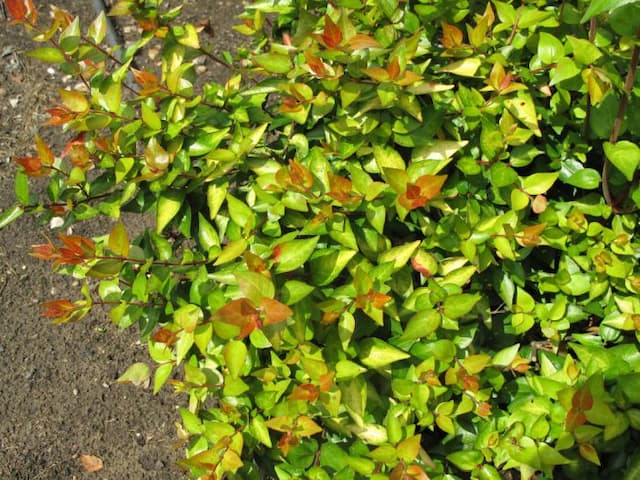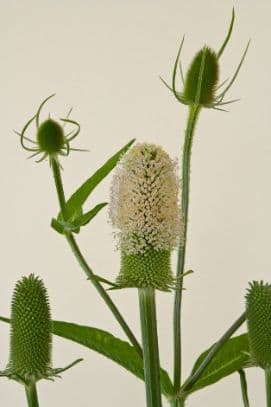Giant Burmese Honeysuckle Lonicera hildebrandiana

ABOUT
Commonly known as the giant Burmese honeysuckle, this plant is an evergreen climbing vine that is well-regarded for its ornamental value. It has large, oval to oblong leaves that are glossy green, providing a dense foliage throughout the year. The leaves serve as a vibrant backdrop to its significantly striking flowers. The flowers of the giant Burmese honeysuckle are the main attraction. They are long, tubular blossoms that can be up to several inches in length, suggestive of the sizable nature of the plant. These flowers often exhibit a creamy white color when they first bloom, gradually transitioning to a deep yellow as they mature. The blossoms emit a sweet fragrance, which becomes more intense in the evening, thus attracting pollinators like moths and possibly hummingbirds. Clusters of small berry-like fruit follow the flowering period. The fruits usually appear in a shade of purple-black when ripe, adding yet another layer of visual interest to the plant. These characteristics together make the giant Burmese honeysuckle a popular choice for gardeners looking to add a tropical touch to their landscape with a plant that offers both visual beauty and fragrant appeal.
About this plant
 Names
NamesFamily
Caprifoliaceae
Synonyms
Giant Burmese Honeysuckle, Hildebrand's Honeysuckle
Common names
Lonicera hildebrandiana.
 Toxicity
ToxicityTo humans
Giant Burmese Honeysuckle is not commonly noted for toxicity to humans. However, general caution should be applied, as with many ornamental plants, since reactions can vary widely among individuals, and ingesting plant material that is not typically considered food can cause discomfort or gastrointestinal upset. It is always wise to avoid ingesting plants not known to be safe or intended for human consumption.
To pets
The Giant Burmese Honeysuckle is not specifically documented for its toxicity to pets, but as with any non-food plant, consumption by pets could potentially lead to gastrointestinal upset or an allergic reaction. As a precaution, prevent pets from ingesting this plant and consult a veterinarian if any suspicious symptoms arise after a pet has been in contact with it.
 Characteristics
CharacteristicsLife cycle
Perennials
Foliage type
Evergreen
Color of leaves
Green
Flower color
Cream
Height
20 feet (6 meters)
Spread
10 feet (3 meters)
Plant type
Climber
Hardiness zones
9
Native area
Southeast Asia
Benefits
 General Benefits
General Benefits- Aesthetic Appeal: Lonicera hildebrandiana, commonly known as Giant Burmese Honeysuckle, adds a lush, tropical look to gardens with its large leaves and fragrant blooms.
- Attracts Pollinators: The plant's vivid blooms are a natural attractor for bees, butterflies, and hummingbirds, thereby supporting local ecosystems.
- Privacy Screen: With its vigorous climbing habit, Giant Burmese Honeysuckle can be used to cover fences, trellises, and walls, creating natural privacy screens.
- Shade Provider: When grown over pergolas or arbors, it offers a living canopy that provides shade for people and habitat for wildlife.
- Erosion Control: Its roots can help stabilize soil on slopes and banks, reducing erosion and promoting soil health.
- Fragrance: The sweet scent of Giant Burmese Honeysuckle flowers can perfume an entire garden, enhancing the sensory experience.
- Cultural Significance: The plant has significance in various cultures for its beauty and use in gardens, which can be of educational interest.
- Versatility: It can be trained to grow in various forms, such as shrubs or groundcover, making it versatile for different garden designs.
 Medical Properties
Medical Properties- This plant is not used for medical purposes.
 Air-purifying Qualities
Air-purifying QualitiesThis plant is not specifically known for air purifying qualities.
 Other Uses
Other Uses- Ornamental Screen: The giant Burmese honeysuckle can be trained to climb over fences and arbors, providing an ornamental and natural screen that offers privacy and aesthetic appeal.
- Shade Provider: With its vigorous and dense foliage, this plant can create shaded areas in gardens, which can help cool down small sections of a landscape during hot days.
- Erosion Control: Its root system can help stabilize soil on slopes or banks, thereby reducing erosion and supporting the surrounding ecosystem.
- Fragrance Source: With its sweet-scented flowers, Lonicera hildebrandiana can be planted to enhance the fragrance in gardens, patios, or near windows to allow the scent to drift indoors.
- Privacy for Wildlife: This dense vine provides excellent coverage and can create private nesting sites for birds and safe havens for various other wildlife.
- Hummingbird Attractant: Its flowers are a natural attractant for hummingbirds, thus aiding in the pollination of the surrounding garden area.
- Photography Subject: The striking flowers and the vine's habit make it an interesting subject for garden photographers and plant enthusiasts who appreciate its unique beauty.
- Natural Sound Barrier: When grown densely, the large leaves of the giant Burmese honeysuckle can help dampen noise, making it beneficial for planting along busy roads or between properties for reduced sound pollution.
- Education and Research: Botanical gardens and educational institutions might cultivate Lonicera hildebrandiana as a specimen for research, educational purposes, or for preserving genetic diversity.
- Culinary Garnish: Although not commonly used for consumption, its flowers can occasionally serve as an edible garnish for a unique visual appeal on special dishes, provided they are free of pesticides and other chemicals.
Interesting Facts
 Feng Shui
Feng ShuiThe Giant Burmese Honeysuckle is not used in Feng Shui practice.
 Zodiac Sign Compitability
Zodiac Sign CompitabilityThe Giant Burmese Honeysuckle is not used in astrology practice.
 Plant Symbolism
Plant Symbolism- Love and Devotion: The Lonicera hildebrandiana, commonly known as the Giant Burmese Honeysuckle, is often associated with love and devotion due to its vigorous growth and the way it clings and intertwines with structures, which can be viewed as an emblem of the bond between lovers.
- Affection: In floral language, honeysuckles can represent the bonds of affection, and the Lonicera hildebrandiana is no exception. Its sweetly-scented flowers suggest a tender and affectionate connection between individuals.
- Generosity: With its abundant and large flowers, the Giant Burmese Honeysuckle symbolizes generosity, indicating a willingness to give joy and happiness to others.
- Fraternal Bonds: Similarly to other climbing plants, the interlacing of its stems can symbolize fraternal bonds and interconnectedness within a community or family.
- Longevity and Everlasting: As a vigorous perennial, the Giant Burmese Honeysuckle may also denote longevity and everlasting life, embodying the eternal aspect of nature.
 Water
WaterGiant Burmese honeysuckle should be watered deeply but infrequently, allowing the soil to dry out slightly between watering sessions to mimic its natural habitat. During the growing season, a rough guideline is to water with about 1 to 1.5 gallons every week or two, depending on the climate and weather conditions. During hot or dry spells, water requirements may increase, while in cooler or rainy periods, watering should be reduced accordingly. During the winter dormancy period, watering should be significantly reduced to prevent root rot, providing just enough water to keep the soil from drying out completely.
 Light
LightGiant Burmese honeysuckle thrives best in partial shade to full sun conditions. It prefers a location where it can receive morning sunlight and afternoon shade, or dappled sunlight throughout the day, which offers protection from the intense heat while providing adequate light for growth. This makes east- or west-facing spots ideal for planting, ensuring it gets the light it needs without being subjected to the harsh midday sun.
 Temperature
TemperatureThe ideal temperature range for Giant Burmese honeysuckle is between 60°F and 85°F, offering a warm and stable environment for growth. While it can tolerate temperatures as low as 40°F for short periods, it is sensitive to frost and prolonged cold exposure. The warmer end of its temperature tolerance spectrum can extend to about 95°F, though it's important to ensure adequate watering during these warmer conditions to prevent stress.
 Pruning
PruningTo maintain the health and shape of Giant Burmese honeysuckle, pruning should be carried out after the flowering season ends to remove spent blooms and encourage new growth. Pruning can also be done in late winter to early spring before new growth begins to remove dead or damaged stems and control the size of the plant. It's typically sufficient to prune once or twice a year, depending on the plant's growth rate and the gardener's aesthetic preference.
 Cleaning
CleaningAs needed
 Soil
SoilGiant Burmese Honeysuckle thrives in well-drained, fertile soil with high organic matter content and a pH of around 5.5 to 6.5. A mix containing peat, loam, and a good amount of compost is ideal to provide nutrients and proper drainage.
 Repotting
RepottingGiant Burmese Honeysuckle should be repotted every 2-3 years to rejuvenate the soil and accommodate the growth of the plant, as it can become root-bound.
 Humidity & Misting
Humidity & MistingGiant Burmese Honeysuckle prefers a moderate humidity level, benefiting from about 40-60% ambient humidity to thrive.
 Suitable locations
Suitable locationsIndoor
Use bright, indirect light and room to climb for indoor Giant Burmese Honeysuckle.
Outdoor
Plant in partial shade, moist soil, and provide support for climbing.
Hardiness zone
10-11 USDA
 Life cycle
Life cycleThe life of Giant Burmese Honeysuckle (Lonicera hildebrandiana) begins with seed germination, which requires a warm, moist environment to sprout. Following germination, seedlings establish themselves and develop into juvenile plants with basic leaves and a root system. As they mature, these juvenile plants grow rapidly, climbing and twining onto supports with their vigorous stems and large leaves, and they may start flowering within a few years under optimal conditions. The flowering stage presents large, fragrant, cream-colored blossoms that are pollinated by insects, leading to the development of red to black berries. These berries, when mature, disperse seeds either through animal consumption or natural fall, thus completing the cycle. In a perennial fashion, the adult plants will continue to grow and produce flowers and fruits each season for many years.
 Propogation
PropogationPropogation time
Spring-Early Summer
The Lonicera hildebrandiana, commonly known as the Giant Burmese Honeysuckle, is generally propagated through semi-hardwood cuttings. The best time for propagation is during the late summer to early fall, when the plant's growth has slowed down but the wood is not fully hardened. To propagate through cuttings, take a 4 to 6-inch (about 10 to 15 cm) cutting from a healthy parent plant, making sure it has several leaves. Strip the leaves from the lower half of the cutting, and dip the cut end in a rooting hormone to increase the chances of successful root development. Plant the cutting in a pot with well-draining soil, and maintain consistent moisture without making the soil soggy. Place the pot in a location with indirect light, where it can be kept at a constant temperature of around 70 degrees Fahrenheit (approximately 21 degrees Celsius). Roots typically develop within 4 to 8 weeks, after which the cuttings can be transplanted to a more permanent location.








